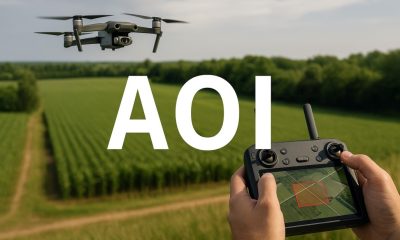German Drone Regulations
German Drone Basic Rules
Published
9 months agoon
Table Of Contents

German Drone Basic Rules – What Are They?
The German Drone Basic Rules provide the foundation for safe and legal drone operations across the country. These rules apply to both recreational and commercial operators and cover essential requirements such as drone registration, maximum altitude limits, and mandatory insurance. Understanding and following the German Drone Basic Rules is crucial for anyone flying a drone in Germany, helping operators stay compliant with regulations set by the Luftfahrt-Bundesamt (LBA) and ensuring the safety of both people and airspace.
Registration Requirements
Mandatory Registration
- Drones over 250 grams: Any drone weighing more than 250 grams must be registered with the LBA. Registration helps authorities monitor drone usage and ensure that each drone is operated within the legal framework.
- Digital Identification: Once registered, the drone must display a digital identification number, which must be clearly visible on the body of the drone. This identification helps trace the operator in case of incidents or rule violations.
Age Requirements
Minimum Age
- For Recreational Operators: The minimum age to operate a drone in the Open Category (low-risk operations) is 16 years old.
- For Commercial Operators: For more advanced operations, such as those in the Specific or Certified Categories, operators must be at least 18 years old and hold the necessary certification.
- Supervision for Minors: If the operator is under 16, drone flights may be conducted under the direct supervision of a qualified adult.
Licensing and Certification
Remote Pilot License (RPL)
- Certification for Commercial Use: Any commercial drone operator must hold a Remote Pilot License (RPL). This ensures that the pilot has the knowledge and skills necessary to safely and legally operate the drone.
- License Requirements: To obtain an RPL, operators must complete a training course approved by the LBA, pass a theoretical exam, and demonstrate practical flying skills. The course covers topics such as airspace regulations, flight safety, and emergency procedures.
- A1/A3 and A2 Certification: Depending on the type of operation, additional certifications may be required. For example, A1/A3 certification applies to operations involving lightweight drones, while A2 certification is necessary for flying closer to people with heavier drones.
Operating Limits
Maximum Altitude
- 120 Meter Limit: Drones must not be flown higher than 120 meters (400 feet) above ground level without special permission from the LBA. This rule helps prevent conflicts with manned aircraft operating at higher altitudes.
- Exceptions: Special permits may be granted for operations that require higher altitudes, such as for industrial inspections or surveying.
Visual Line of Sight (VLOS)
- VLOS Requirement: Drones must be operated within the visual line of sight of the pilot at all times. This means the drone must remain visible to the operator without the use of binoculars or other visual aids.
- Beyond Visual Line of Sight (BVLOS): BVLOS operations are only permitted with special approval and under strict conditions. These types of operations require advanced safety protocols and certifications.
Distance from People and Property
Safe Distances
- People and Buildings: Drones must be kept at a safe distance from people, buildings, and vehicles. In general, drones must remain at least 50 meters away from uninvolved people and property.
- Crowded Areas: Flying drones over crowds, festivals, or events is strictly prohibited unless special permission has been obtained. This rule is designed to prevent injuries and accidents in densely populated areas.
No-Fly Zones
Restricted Airspace
- Airports and Aerodromes: Drones are not permitted to fly within 1.5 kilometers of airports or aerodromes without prior authorization from air traffic control. This restriction is in place to avoid collisions with manned aircraft.
- Government and Military Sites: Drones are also prohibited from flying near government buildings, military installations, and other sensitive infrastructure. The LBA provides a map of restricted areas that drone operators must review before each flight.
Nature Reserves and Protected Areas
- Environmental Protection: Drones are not allowed to fly over nature reserves, wildlife sanctuaries, or protected areas without permission from environmental authorities. This helps preserve natural habitats and protect wildlife from disturbances.
Night Operations
Lighting Requirements
- Anti-Collision Lights: Drones operated at night must be equipped with anti-collision lights visible from at least 3 nautical miles. This ensures the drone remains visible to the operator and other airspace users.
- Special Permissions: Night operations require special permission from the LBA, and the operator must demonstrate the ability to manage the increased risks associated with low visibility conditions.
Summary
Adhering to the German Drone Basic Rules is essential for maintaining legal and safe drone operations in Germany. By following these fundamental guidelines, including registration, altitude restrictions, and respecting no-fly zones, drone operators can minimize risks, avoid penalties, and contribute to a safer airspace. Compliance with the basic rules ensures that drone activities remain responsible and within the framework of German and EU aviation regulations.
To Learn more about acronyms used in this article visit our Drones Acronym Page.











